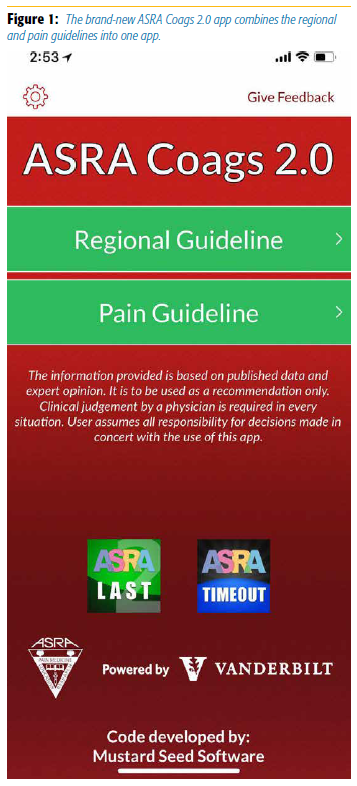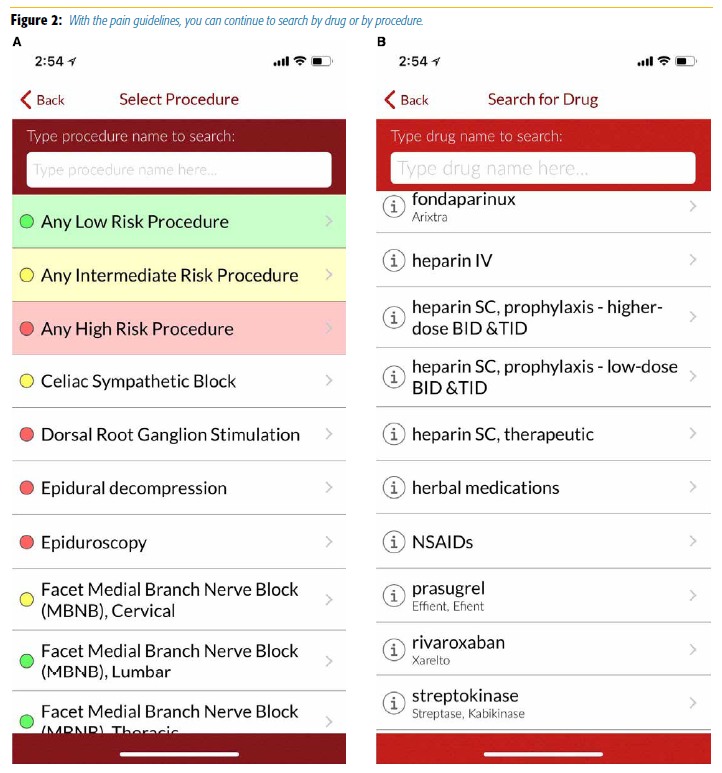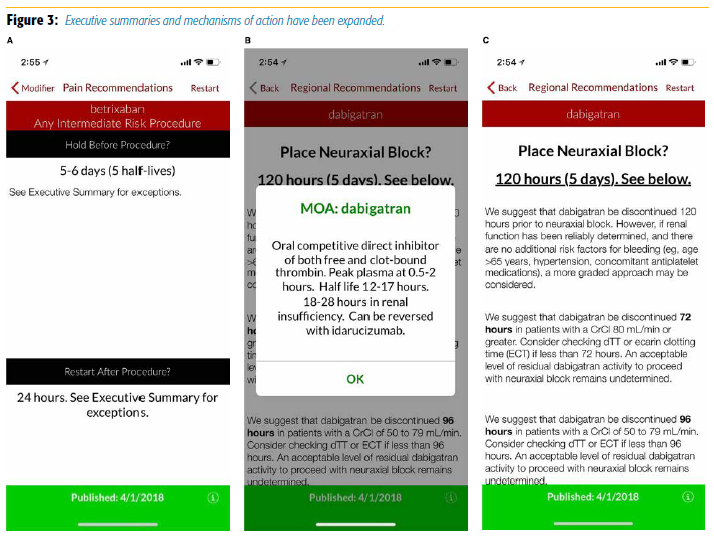What's New with ASRA Coags 2.0?
With the release of the ASRA Coags 2.0 app, I wanted to give you some history of where the app came from and what's new in this latest version. The app has been a critical part of my practice in regional anesthesia, and many people around the globe find it useful for theirs.
“All of the information is embedded in the app itself, so it can be accessed even without an internet connection.”
In 2010, ASRA released the third edition of the often-cited and frequently used Regional Anesthesia in the Patient Receiving Antithrombotic or Thrombolytic Therapy: American Society of Regional Anesthesia and Pain Medicine Evidence-Based Guidelines.[1] Because of the increasing use of antithrombotic, anticoagulant, thrombolytic, and antiplatelet medications throughout medicine for the management of coronary artery disease, stroke, deep venous thrombosis, and many other disorders, practicing safe regional anesthesia has become more complex. It is essential that anesthesiologists understand the pharmacokinetics of various medications and the implications for neuraxial and peripheral blocks. However, the guidelines are nearly 100 pages long, making it very difficult for most clinicians to locate and execute best practices during a busy clinical day.
When the guidelines were first released, many people were making their own charts or electronic mnemonic tools to effectively access this information. In 2014, ASRA created the ASRA Coags Regional app to help with this problem. The app is a searchable database tool on your iOS or Android device that accesses the same information as the 2010 guidelines but in a quick and readable format. Buried inside the app, however, is the complete depth and nuance of the original publication when necessary. This app has been a resounding success, with more than 25,000 downloads from around the world in the past 4 years.
In 2015, ASRA collaborated with the European Society of Regional Anesthesia and Pain Therapy, American Academy of Pain Medicine, International Neuromodulation Society, North American Neuromodulation Society, and the World Institute of Pain to establish the first edition of guidelines for antiplatelet and anticoagulation management for interventional pain procedures: Interventional Spine and Pain Procedures in Patients on Antiplatelet and Anticoagulant Medications.[2] ASRA subsequently produced a new app called ASRA Coags Pain to include the new pain guidelines that were distinct from regional anesthesia guidelines in many ways.
Both ASRA Coags Regional and ASRA Coags Pain have demonstrated the value of app-based guidelines in enhancing the ability of practitioners to access and use published best practices in efficient ways.[3] In addition, the apps provided a validated way for ASRA to disseminate the information so that users could have confidence in the quality of the content.[4]
However, because of the expanding number of new medications in the past several years, both the regional and pain guidelines needed updating. ASRA put tremendous effort in updating both guidelines simultaneously, culminating in publications released in the Regional Anesthesia and Pain Medicine journal in April 2018.[5] Both sets of guidelines address the growing number of new medications available on the market and update previous guidelines with new information from literature published during the intervening years. The updates have been long-awaited and will be very influential in many clinicians' practices around the globe.
ASRA felt it was essential to revise the ASRA Coags apps with the latest guidelines as quickly as possible, giving providers access to the most current information. In addition, we knew that it was essential to access both guidelines in one place since many clinicians practice in both arenas. This resulted in the April 2018 release of the brand-new ASRA Coags 2.0 app that combines regional and pain guidelines into one app, in concert with the new guidelines (Figure 1).

We've made many improvements to enhance app users' experience and content. Both iOS and Android versions have been updated to be consistent with the latest operating systems, ensuring compatibility with the most common devices. The user interface has been modernized to reflect the look and feel of today's apps. When first opening the new app, users have the option of maintaining the home screen's default settings with both regional and pain guidelines or changing the default to their preferred guideline for faster access in future uses. With the pain guidelines, you can continue to search by drug or by procedure, depending on how you approach your diagnostic problem (Figure 2).

In the Settings menu, we continue to give people the option to opt in or opt out from data tracking, although data tracking is only used by ASRA's researchers to better understand how people use the guidelines. Within the app, the executive summaries and mechanisms of action have been expanded (Figure 3). All of the information is embedded in the app itself, so it can be accessed even without an internet connection.

The ASRA Coags 2.0 app is an exciting, useful update for clinicians who have been seeking new guidance in this field: In the first week of its release, the majority of users had already updated to the newest guidelines. In fact, with its ease of use and ready accessibility, referring physicians and clinics can use the app to better prepare their patients before they arrive for their procedure, thereby reducing unnecessary cancellations, delays, or avoidance of appropriate regional anesthesia.
The update is free to anyone who had purchased the ASRA Coags Regional app. The ASRA Coags Pain app will be discontinued. ASRA Coags 2.0 is available on the iOS and Google Play app stores for $3.99.
References
- Horlocker TT, Wedel DJ, Rowlingson JC, et al. Regional anesthesia in the patient receiving antithrombotic or thrombolytic therapy: American Society of Regional Anesthesia and Pain Medicine Evidence-Based Guidelines. 3rd ed. Reg Anesth Pain Med. 2010;35:64–101.
- Narouze S, Benzon HT, Provenzano DA, et al. Interventional spine and pain procedures in patients on antiplatelet and anticoagulant medications: guidelines from the American Society of Regional Anesthesia and Pain Medicine, the European Society of Regional Anaesthesia and Pain Therapy, the American Academy of Pain Medicine, the International Neuromodulation Society, the North American Neuromodulation Society, and the World Institute of Pain. Reg Anesth Pain Med. 2015;40:182–212.
- Gupta RK, McEvoy MD. Initial experience of the American Society of Regional Anesthesia and Pain Medicine Coags Regional smartphone application: a novel report of global distribution and clinical usage of an electronic decision support tool to enhance guideline use. Reg Anesth Pain Med. 2016;41:334–338.
- Neal JM, Stengel A, Huntoon MA. Creating, and protecting, the American Society of Regional Anesthesia and Pain Medicine's intellectual property. Reg Anesth Pain Med. 2016;41:3–4.
- Horlocker TT, Vandermeuelen E, Kopp SL, et al. Regional anesthesia in the patient receiving antithrombotic or thrombolytic therapy: American Society of Regional Anesthesia and Pain Medicine evidence-based guidelines. 4th ed. Reg Anesth Pain Med. 2018;43:263–309.
- Narouze S, Benzon HT, Provenzano D, et al. Interventional spine and pain procedures in patients on antiplatelet and anticoagulant medications. 2nd ed. Guidelines from the American Society of Regional Anesthesia and Pain Medicine, the European Society of Regional Anaesthesia and Pain Therapy, the American Academy of Pain Medicine, the International Neuromodulation Society, the North American Neuromodulation Society, and the World Institute of Pain. Reg Anesth Pain Med. 2018;43:225–262.
Leave a commentOrder by
Newest on top Oldest on top